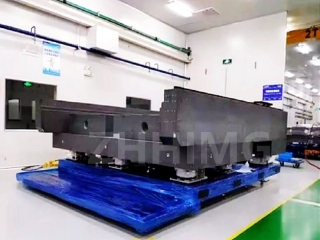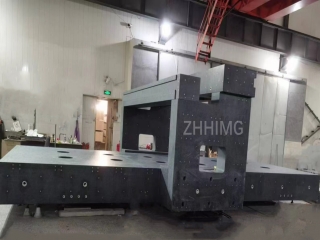In the factory that manufactures precision parts, the XYZ precision gantry frame is like a "super plotter", capable of precise movement at the micrometer or even nanometer scale. The granite base is the "stable table" that supports this "plotter". Can they really "work in perfect harmony" when paired together? Today, let's uncover the mystery within.
Why are they said to be a "perfect match"?
Granite is no ordinary stone. It is like a "hexagonal warrior" in the materials world:
Outstanding shock absorption capacity: Granite has an extremely high density, and its internal structure is like a "tight jigsaw puzzle". When the gantry frame moves rapidly and vibrates (just like how it shakes when braking suddenly while running), granite can absorb over 90% of the vibration energy, allowing the gantry frame to quickly "stand firm". For example, when grinding optical lenses, after using the granite base, the shaking amplitude of the gantry frame was reduced from 15 microns to 3 microns, and the precision of the lenses was greatly improved.
Not afraid of temperature "disruption" : The gantry frame will heat up after long-term operation. Ordinary materials will "expand and deform" when heated, but the thermal expansion coefficient of granite is only one fifth of that of steel! Even if the temperature in the workshop changes by 10℃ within a day, its deformation can almost be ignored. It can firmly support the gantry frame and ensure that the positioning error does not exceed 2 microns.

Will they also "have conflicts"? These issues should be noted!
Although they are "very compatible", if not well planned in the early stage, "incompatibility with the local environment" may also occur:
The embarrassment of "interfaces not matching"
The sliders and guide rails on the gantry frame need to be precisely installed in the holes of the base. If the deviation of the holes on the base exceeds 0.01 millimeters (thinner than a human hair), the gantry frame may be tilted when installed and get stuck when moved. Just like when the joints of a jigsaw puzzle don't match, no matter how hard you try, it just won't work.
The hidden danger of "weight mismatch"
Large gantry frames are heavy and "strong". If the granite base is not solid enough (with a compressive strength lower than 120 megapascals), it may crack under long-term heavy pressure. This is like supporting a big stone with small branches. Sooner or later, it will break.
The trouble of "asynchronous thermal expansion and contraction"
The degree to which metal gantry frames and granite expand when heated is different. In an environment with a large temperature difference, the two may "compete" with each other to generate stress, causing the equipment to be unstable, just like parts made of different materials "going their own way" at high temperatures.
How to make them "perfectly cooperate"?
Don't worry. There are solutions to these problems:
Tailor-made base: Measure the weight of the gantry frame, installation hole positions and other data in advance, and let the manufacturer customize a dedicated base to ensure that the error of each hole position does not exceed 0.005 millimeters.
Reinforce and upgrade the base: Select granite with higher compressive strength (≥150 megapascals), and also design a honeycomb structure inside the base, just like a bee's hive, which not only reduces weight but also enhances load-bearing capacity.
Install "Temperature Control Guardian" : Add a layer of flexible gasket between the base and the gantry frame to absorb thermal stress; Or install water-cooling pipes to keep the temperature variation within 1℃.
Post time: Jun-17-2025

